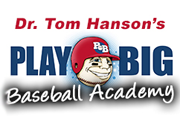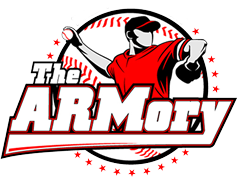Who’s To Blame? Balancing Performance Enhancement With Injury Risk Reduction
I’m probably going to catch a lot of flack for this e-mail,
but here goes anyway.
In early March of this year, I scrubbed in to observe a surgery
with Tampa Bay Rays Team Doctor Koko Eaton.
I wanted to see a Tommy John (ulnar collateral ligament) reconstruction.
Over my 20 years as a practicing Physical Therapist, I had seen
every injury imaginable. I had observed lots of different surgical procedures,
but I had never seen a Tommy John surgery.
I wanted to see this particular surgery because I knew this patient personally.
The patient was an 18 year-old 6’4” right-handed pitcher.
He was in his senior year and was topping out at 84 mph.
For privacy purposes, I’ll call him John.
John came into the ARMory for an evaluation in mid December.
I performed a thorough assessment and found a few inefficiencies
I thought might place his performance and durability in question.
He only had time to work out with us for about 4 or 5 sessions before
his high school team began practicing for the spring season.
After that, he was unable to get to The ARMory, but he hoped
to continue working with us after the season ended.
Having had no pain during several intrasquad outings prior to his injury,
he removed himself from his first preseason game with medial elbow pain.
I happened to be at the game.
I examined him at the field and set him up immediately with Dr. Eaton.
As I suspected, the results of the MRI showed a full
thickness tear in the right UCL.
John was scheduled for surgery on March 8th.
So the first question everyone wants to ask whenever a pitcher gets injured is:
“Who’s to blame?”
“Who’s fault is it that this young man got hurt?”
Do we blame his high school coach?
Was he overusing the John?
–No. John was a reliever who had thrown less than 30 total innings
in his 4 years of high school. His coach is highly respected in the
baseball community and has no history of overusing pitchers.
How about his travel ball coach?
Did that guy make him pitch on back-to-back days too many times?
Did they run his pitch count up?
–By all accounts, this was not the case.
John’s father is a former major leaguer who strictly managed
his pitch counts and workloads.
What about blaming me?
After all, he had worked out at The ARMory with me a few times
just 3 months before his injury.
I say the answer is you don’t blame anyone.
I’ll elaborate:
ALL injuries are multifactorial.
Barring something like an acute fracture due to a fall,
injuries are usually due to a multitude of factors.
There are no direct causes of injuries,
but there are a ton of possible contributors.
Pitching at a high level is a relatively dangerous enterprise by nature.
As I have often heard my friend Ron Wolforth say,
“The only safe pitch count is zero.”
In a recent study published in the American Journal of Sports Medicine,
America’s foremost authority on the UCL and Tommy John surgeries,
the author says the following:
“….it may appear that minimizing the risk of injury (ie, decreased kinetics)
and maximizing performance quality (ie, increased ball speed) are
incompatible with one another.
However, there may be an optimal balance in timing that is effective
for satisfying both outcomes”
In other words: If you want to throw hard, you’ll have to assume a
certain degree of risk, but you must do your best to manage that risk.
Guys who throw 95 sometimes get hurt.
Guys who throw 80…not so much.
But here’s the most enlightening truth I found in following John’s injury.
During the surgery, Dr. Eaton used a metal probe to lift the torn fragment
of John’s UCL. He looked at me and said,
“Randy, look at the thickening and hypertrophy of this piece of the old ligament.
That’s evidence that this young man had torn and healed his ligament several
times before the latest injury.”
Did you catch that?
John had torn his ligament several times in the past.
He was throwing 84mph with an insufficient UCL.
See, Tommy John ligament tears are rarely due to a single episode.
Instead they become loose and unstable over a long period of time
until one day the just give way.
Can you really hold his high school coach, his travel ball coach
or his pitching instructor accountable for something that has occurred
gradually over the course of his entire life?
I spoke to the father of another college pitcher recently diagnosed
with a UCL tear and he said casually,
“You know when my son was 14 he used to finish pitching and have
this giant bruise on the inside of his elbow.
I thought he was just busting blood vessels because he was throwing so hard.”
So do we blame that kid’s college coach for that???
I think we can all agree, the answer is no!
To point the finger at one episode, person, or behavior in such an incredibly
complex matrix of contributing factors is completely unfair to everyone involved.
One more study to report and then I’ll stop my rant.
This study described the amount of valgus torque on the UCL during the
pitching motion.
At full lay back (external rotation) of the shoulder in the delivery the torque on the UCL
is around 70 Newton-meters.
Don’t worry about what a Newton-meter is, just remember the number 70.
Another group of researchers wanted to find out how much torque it takes to tear
a UCL in a cadaver. They found that number to be 35 Newton-meters.
What?
You can tear it on a dead guy at 35, but it has to accept 70 with every pitch????
That means your Tommy John ligament should tear with every single pitch!!!
How is that possible?
No pitcher should ever be able to remain healthy!
Well, you have to learn to attenuate the torque on your UCL by distributing
it over a vast network of assistors.
The pronator muscles in the forearm must help.
The shoulder and scapular complexes must help.
And you must use your hips, legs and torso to assist.
And they all have to work in sync at exactly the right time.
All of those factors must combine to reduce that torque number from 70
to below 35, so the ligament doesn’t rip off the bone with every pitch.
Everyone who shows up at The ARMory is eager to gain velocity.
Honestly, injury prevention does not sell.
Velo is the sexy girl everyone is after.
However, if you want to gain velocity safely, I would recommend you train
with a pitching instructor who understands the kinematics of the pitching motion
and the unusual demands it places on the human body.
That’s where I come in.
I have already done the research and I am uniquely qualified to help you
gain velocity in the safest way possible.
Can I guarantee that no one will ever get hurt?
No way. I’d be lying if I said I could.
But I can use my unique blend of baseball and medical knowledge
to reduce that risk as much as possible.
You’ll make gains….everyone in our program does.
And you’ll have a level of comfort in knowing that I have studied all the
cutting edge research to ensure the risk of injury is reduced to the lowest level possible.
Balance between performance enhancement and injury risk reduction.
That’s the key
And it starts with our initial evaluation.
We’ll do a thorough head to toe analysis of your body, your athleticism,
and your movement patterns
to identify all significant opportunities for improvement.
Our evaluations take about 2 hours to perform.
With the exceptions of June 11th and June 20th which will be reserved for
2 special event seminars, we will be performing evaluations every
Tuesday night at 6 pm starting on June 4th and continuing
through the entire summer.
Click here to register for your assessment
http://armorypitching.us6.list-manage1.com/track/click?u=1f38f19043edbc4be623f5ce5&id=2d7236d112&e=caf3198419
But you don’t have to wait for an assessment date to get started.
Click here to register for our Exciting 2013 Rocket Launchers Summer Training Program
http://armorypitching.us6.list-manage.com/track/click?u=1f38f19043edbc4be623f5ce5&id=9b99ad25e7&e=caf3198419
The first day of every 4 week summer session will be evaluation day.
That’s where we’ll establish our baseline and identified significant opportunities
for improvement.
Until next time,
Blow it up!
Let it eat!
But make sure you live to fight another day.
Randy Sullivan, PT
CEO, The ARMory Power Pitching Academy









Leave a Reply